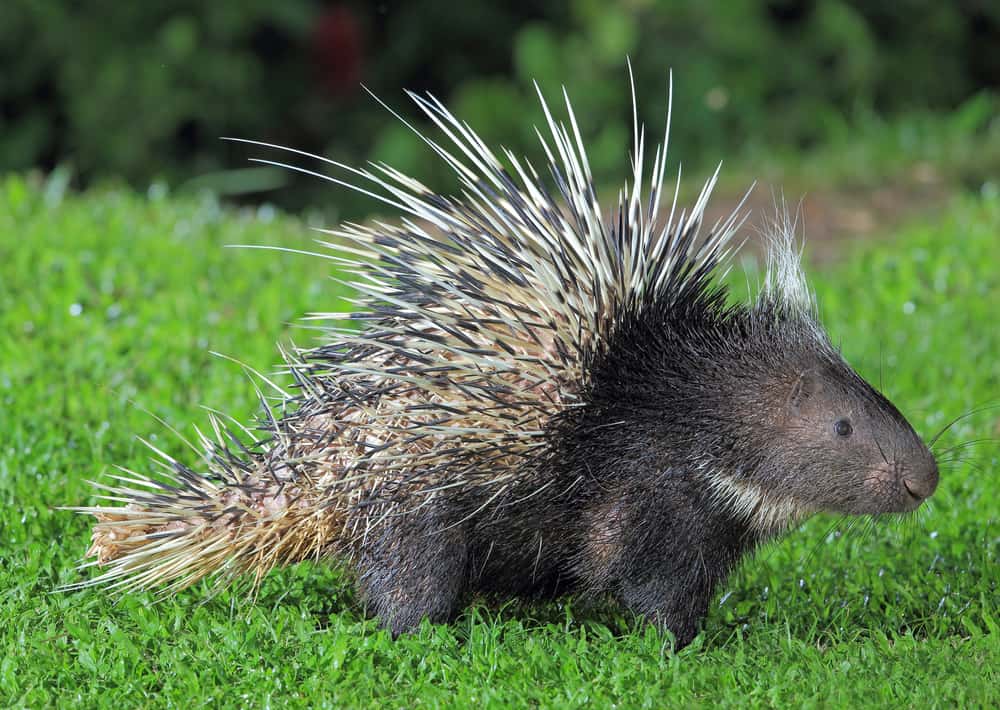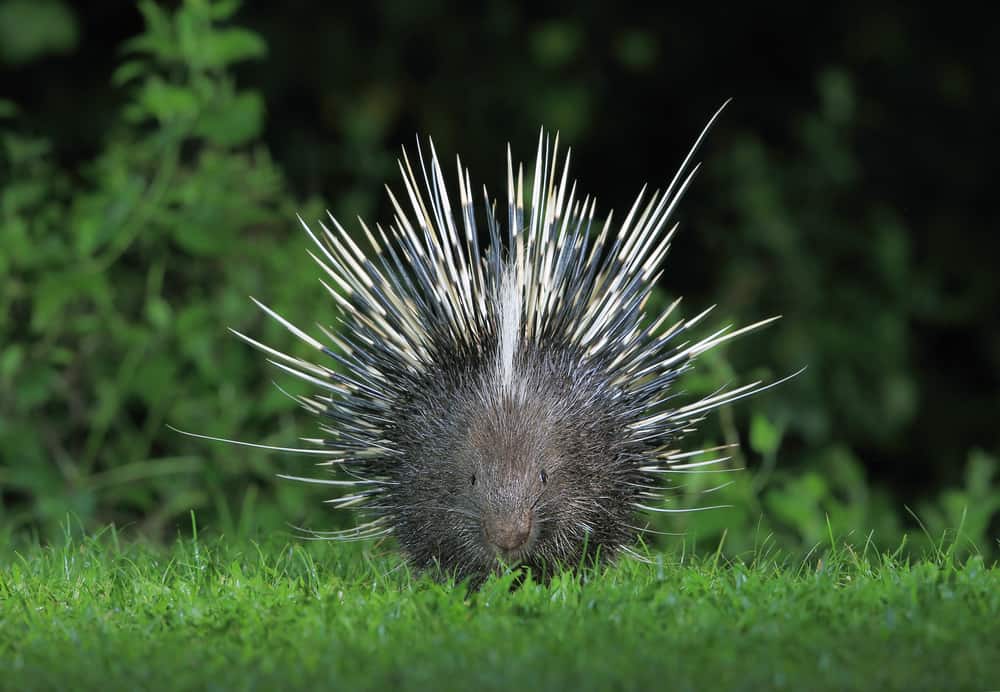Erethizontidae is a family of rodents that belong to the order Rodentia. They are commonly known as New World porcupines and are distributed in North, Central, and South America.
This family comprises 13 species that have unique morphological features such as sharp quills on their back for protection against predators.
The Erethizontidae family exhibits diverse ecological habits and can be found in various habitats ranging from tropical rainforests to deserts. Their diet consists primarily of bark, leaves, fruits, seeds, and occasionally insects.
Due to their large size and slow movement, they do not face significant threats from predators but have been hunted by humans for their meat and quills since ancient times.
In this article, we will provide an overview of the taxonomic classification, morphology, distribution, habitat preferences, behavior patterns and conservation status of the Erethizontidae family.

Genera
- Genus Chaetomys – bristle-spined rat
- Genus Coendou – prehensile-tailed porcupine
- Genus Erethizon – North American porcupine
Taxonomic Classification
Erethizontidae is a family of large, arboreal rodents that are commonly known as New World porcupines. These animals are found throughout the Americas, from southern Canada to northern Argentina. The evolutionary history of the Erethizontidae dates back to the Oligocene epoch, approximately 23 million years ago.
Phylogenetic relationships within this family have been studied extensively, and it has been determined that there are two main subfamilies: Erethizontinae and Chaetomyinae. The Erethizontinae subfamily includes all extant species of New World porcupines except for one genus, which is included in the Chaetomyinae subfamily.
Within the Erethizontinae subfamily, there are three genera: Coendou, Sphiggurus, and Echinoprocta. The Chaetomyinae subfamily includes only one genus: Chaetomys.
Despite their similar appearance to Old World porcupines, New World porcupines evolved independently and represent a distinct group of hystricognath rodents with unique morphological features.
Morphological Features And Adaptations
Moving on from the previous section, it is worth noting that erethizontidae species have certain morphological features and adaptations that make them stand out in their environment.
These porcupine-like creatures are known for having long quills covering their entire body, which act as one of their primary defensive mechanisms against predators. When threatened, these animals can raise their quills to appear larger and create a barrier around themselves.
Apart from this striking feature, erethizontidae also exhibit unique locomotion strategies. They possess strong legs with sharp claws that enable them to climb trees effortlessly. Additionally, they have prehensile tails that help them maintain balance while climbing or moving through branches at high altitudes.
Through such adaptations, erethizontidae demonstrate remarkable agility in navigating their natural habitat while avoiding danger or seeking food sources.
Distribution And Habitat Preferences
Morphological features and adaptations play a crucial role in the survival of erethizontidae, commonly known as porcupines. The family Erethizontidae includes 11 species and is found in North and South America. These rodents are characterized by their sharp quills that cover their backs, making them almost invincible to predators.
Porcupines have adapted unique morphological features such as strong incisors for gnawing on bark and twigs, specialized stomachs for digesting cellulose-rich plant materials, and long claws for climbing trees.
Geographical range plays a significant role in determining the ecosystem requirements of porcupines. Although they are not picky eaters, different species prefer different habitats based on food availability. Some live in mountainous regions with coniferous forests while others thrive in grasslands or tropical rainforests. Additionally, most porcupine species require access to water sources since they need regular hydration.
Understanding the geographical range and specific habitat preferences can help conservation efforts to protect these fascinating creatures from habitat loss due to human activities such as deforestation and urbanization.
Habitat loss due to human activities such as deforestation threatens the survival of porcupine populations worldwide.
Dietary Habits
Erethizontidae, commonly known as the New World porcupines, are herbivorous mammals that feed on a variety of plant material. Their feeding behavior is largely dependent on the availability and nutritional value of their food sources.
These animals primarily consume leaves, bark, fruits, flowers, twigs and stems. They have specialized teeth for chewing tough plant materials like bark and branches.
The nutritional requirements of erethizontidae vary with age, sex and reproductive status. Adult males require more nutrition than females due to their larger size and higher activity levels. Pregnant females need adequate protein intake for fetal development while lactating mothers require high energy foods to produce milk for their young ones.
The diet of these rodents also changes seasonally; they rely more heavily on coniferous needles during winter months when other plants are scarce. Overall, these animals maintain a balanced diet by selecting different parts of various plant species throughout the year in order to meet their dietary needs.
Predators And Threats
Erethizontidae, commonly known as New World porcupines, exhibit a diverse range of dietary habits that vary depending on their habitat and geographic location. These nocturnal herbivores feed primarily on bark, twigs, leaves, fruits, and sometimes insects. Some species have also been observed consuming carrion or bones for added nutrients. Porcupines have an adaptive digestive system which allows them to extract maximum nutrition from tough plant materials.
Despite being elusive animals with few natural predators due to their spiny defense mechanism, the ecological impact of human interaction with Erethizontidae has become a growing concern.
Habitat destruction caused by deforestation and urbanization leads to fragmentation of habitats making it difficult for these animals to find sufficient food supplies and mates. Additionally, they are susceptible to road accidents while foraging near highways at night.
Furthermore, illegal hunting practices pose a significant threat to the survival of some porcupine species in certain regions where they are hunted for meat or traditional medicine purposes.
It is essential that conservation efforts be undertaken to protect these unique creatures from extinction. We must work towards mitigating human impacts such as habitat fragmentation and roadkill through effective land-use policies and education campaigns aimed at promoting responsible driving behavior around animal habitats.
By implementing measures like protected areas management plans coupled with appropriate law enforcement strategies we can help preserve this fascinating family of rodents for future generations to enjoy.

Conservation Status And Efforts
The conservation status of the erethizontidae family is a matter of concern for wildlife enthusiasts and researchers alike. The population trend of this family varies among species, with some showing stable or increasing numbers while others are facing threats such as habitat loss, hunting and poaching. The North American porcupine (Erethizon dorsatum), for instance, has a stable population thanks to its adaptability to various habitats, while other species like the Brazilian porcupine (Coendou prehensilis) and the Mexican hairy dwarf porcupine (Sphiggurus mexicanus) face greater risks due to habitat fragmentation and deforestation.
To address these concerns, several collaborative initiatives have been launched by governments, NGOs and local communities across their range countries. These efforts aim to protect critical habitats through reforestation programs, engage in anti-poaching measures and raise public awareness on the importance of conserving these unique animals. Public awareness campaigns play an important role in changing people’s attitudes towards wildlife conservation issues. By highlighting the ecological significance of erethizontidae members in maintaining healthy ecosystems, it helps promote ethical behavior towards these animals that ultimately supports sustainable development goals.
| Species | Conservation Status | Threats | Range |
|---|---|---|---|
| Erethizon dorsatum | Least Concern | None known at present | North America |
| Coendou prehensilis | Vulnerable | Habitat destruction; Hunting/poaching pressure from humans | Central/South America |
| Sphiggurus mexicanus | Near Threatened | Habitat loss due to urbanization; Hunting/poaching pressure from humans | Mexico |
In summary, conservation efforts aimed at protecting erethizontidae populations are ongoing but require continued support from all stakeholders involved. Collaborative initiatives that incorporate scientific research alongside community-based approaches can help ensure long-term conservation success. Public awareness programs are also necessary to inform and educate people on the importance of conserving these unique animals for future generations. By working together, we can help protect these fascinating creatures and the ecosystems they inhabit.
Conclusion
Erethizontidae, commonly known as New World porcupines, are a family of rodents that inhabit the Americas. They are characterized by their spiky quills and slow-moving nature.
Their unique morphological features allow them to adapt to various environments ranging from forests to deserts. These herbivorous animals primarily rely on bark, leaves, and fruits for sustenance. However, they have been observed consuming insects and small vertebrates when necessary.
Despite having limited natural predators due to their sharp quills, humans pose a significant threat through hunting and habitat destruction. Efforts to conserve these fascinating creatures involve educating the public about the importance of preserving their habitats and implementing laws against illegal poaching.
Increased protection measures could aid in preventing this species’ decline or extinction. In conclusion, Erethizontidae play an essential role in maintaining ecological balance in the American ecosystem. As we continue to learn more about these remarkable animals, it is our responsibility to protect them from human-induced threats so that future generations can appreciate their beauty and significance in nature’s intricate web.
